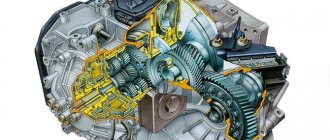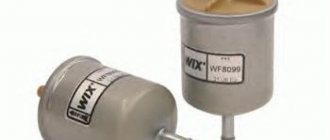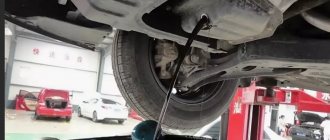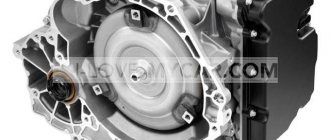Nissan Almera Classic is a compact sedan produced from 2002 to 2012. It was made with two types of transmission - a five-speed manual and a four-speed automatic RE4F03A. The advantage of such a box is its simplicity and very high reliability. Disadvantages - floating blocking of the gas turbine engine (hydrodynamic transformer), which reduces the service life of the filled oil. This means that it needs to be changed regularly. This can be done both in a service center and at home.
Frequency of oil changes in automatic transmission Nissan Almera Classic
The manual for the automatic transmission of the Nissan Almera Classic B10 says that a partial fluid change can be done every 30 thousand kilometers, and a complete change after 60 thousand. This interval is typical for normal operating conditions. In extreme cases, replacement should be made more often.
If the car is constantly operated with overloads and overheats, then the replacement time can be reduced to 20 thousand km with a partial replacement and up to 50 thousand km with a complete replacement.
If you do not change the automatic transmission oil in time, it becomes liquid, sediment particles float in it, which has a bad effect on the lubricity. The automatic transmission begins to shift with hesitations and jerks, and wears out faster, which is fraught with breakdowns. And repairing a machine is not cheap.
Problems with gear shifting indicate that it is time to change the oil, even if the due date has not yet arrived. You can also evaluate its appearance using the probe. The product to be replaced is dark and contains particles of impurities.
Lubricant selection
One of the key points in the matter of successfully replacing the working fluid in an automatic transmission is its correct selection. A noteworthy fact: car owners often use non-original transmission lubricant for Nissan Almera Classic car boxes.
Moreover, judging by the reviews, no one had any problems. For other models of this manufacturer, recommendations from owners regarding the use of non-original oil are more difficult to find.
So, which automatic transmission lubricant for Almera Classic should you choose? The original fluid produced by Nissan will always be beyond competition. Order code for this oil: KE90899931R. It is supplied in liter containers.
As analogues, you can select synthetic gear oil from other manufacturers. Preferably based on DEXRON III. Many people use inexpensive analogues. But with the caveat that they try to replace it more often, after 40–50 thousand kilometers.
Which oil to choose for automatic transmission Nissan Almera Classis
For Nissan Almera Classic, the manufacturer recommends the branded Nissan ATF Matic Fluid D. It is red and sold in 4-liter cans. It is undesirable to use non-original ones, but if it is not possible to purchase a Nissan one, then there are such analogues:
- Petro Canada Duradrive MV Synthetic ATF;
- Mobil ATF 320 Dexron III.
You can choose others. It is important that the product meets Dexron III requirements.
A little history
The first model of this series, the Nissan Almera N14, was released back in 1991. Now this car is considered a rarity. The Japanese concern produced it from 1991 to 1995. Since 1995, the second modification, much better known, began to be produced under the name Nissan Almera N15. The car has been completely updated, the body design has also changed. It was more focused on the European market. Japanese drivers knew the equivalent of this car as the Pulsar.
For some time, the car was produced in 3- and 5-door hatchback bodies, but since 1996 a sedan with 4 doors appeared. The engines mainly offered were:
- 1.4 l with a capacity of 87 hp. pp., gasoline;
- 1.6 l with a capacity of 99 hp. pp., gasoline;
- diesel 2.0 l. (75 hp).
In 1998, the N15 underwent cosmetic restyling, and since 2000 it was replaced by the third generation - the Nissan Almera N16. The car received a different platform, engines and gearboxes. The arsenal included petrol engines with a volume of 1.5 and 1.8 liters, as well as a 2.2 liter turbocharged diesel engine. The model was equipped with a 5-speed manual transmission and a 4-speed automatic transmission. So, with a slight restyling in 2003, production of N16 continued until 2006.
Since 2006, an interesting modern car called the Nissan Almera Classic N16, made in South Korea, began to be sold in Russia. It was made by Samsung together with Renault, modernizing the previously produced Almera under a different name - Renault-Samsung SM3. Under the hood of this car there was only a 1.6-liter gasoline engine with a capacity of 107 horses. There were two gearboxes: a 5-speed manual transmission and an automatic transmission with 4 gears. The body is a five-door sedan.
Today, the 4th generation Nissan Almera Classic is driving on Russian roads, which began selling in 2013, but the N16 modification is still popular among car enthusiasts.
Checking the oil level
How to assess the oil level in a Nissan Almera Classic B10 automatic transmission:
- Start the internal combustion engine, let it idle or drive a little so that it warms up to about 70 degrees - its operating temperature.
- Place the car on a flat, straight surface and turn off the engine.
- Unscrew the dipstick and wipe with a soft cloth until it is clean.
- Dip the dipstick into the oil again and check the level. If it is at the Hot mark, then you can safely continue driving. If the oil is low and the replacement period has not yet arrived, then top up.
It is also worth assessing the appearance of the lubricating fluid: if it is darkened or contains suspended particles of impurities, then it is better to replace it.
When to change
Professional technical staff recommend that car owners adhere to the specified deadlines. They have no right even if they want to. The wear of the automatic transmission is influenced by many factors: from driving style to the quality of the compounds being poured.
If they follow a measured driving style on smooth city roads and fill in high-quality oil, car owners come for replacement on time or a little earlier - the gearbox works out its 60 thousand km without complaints. Carry out the check according to maintenance (every 15 thousand km).
Anyone who is forced to periodically give the car non-recommended loads should check the condition of the oil and diagnose faults more often than scheduled maintenance of 15 thousand km.
Necessary spare parts, tools and consumables
Here's what you'll need to change the transmission oil in an Almera Classic automatic transmission:
- pliers;
- a set of keys;
- containers with measured volume divisions, you can use empty plastic bottles;
- gloves;
- funnel or watering can;
- Nissan automatic transmission filter;
- pan gasket;
- seal for cork;
- rags.
And, of course, new oil to fill the gearbox. You can change the lubricating fluid partially or completely. In the first case, fresh product is poured immediately after draining the old one. This will require approximately 5 liters of lubricant. A complete replacement involves draining, washing and only then refilling. This method will require twice as much oil.
We will show you how to change your engine oil
We recommend that you be present when changing the engine oil in the repair area.
The workshop foreman is constantly in the repair area and will answer any of your questions about changing engine oil.
Observe the engine oil change through the panoramic windows of the customer area.
We recommend replacing engine oil in a 200-liter drum. Oil in 4 and 5 liter canisters is more expensive, but you can use the rest for topping up if necessary. You can also buy any oil in a 1-liter canister for refilling.
Unscrew the oil pan drain plug.
Drain the used engine oil. Draining takes about 1 minute. We recommend monitoring the engine oil drainage.
Unscrew the old oil filter using a puller.
Install a new oil filter. The filter sealing collar is lubricated with oil before installation. The oil filter is tightened tightly by hand.
Pour new engine oil into a measuring container. Each type of oil has its own measuring containers. The type of oil is indicated on the sticker of the measuring container.
IMPORTANT!!! Be sure to replace the disposable copper oil pan drain plug sealing washer. If the washer is reused, there is a risk of oil leakage or damage to the oil pan threads due to excessive force when tightening the drain plug.
Pour new engine oil into the engine. We recommend being present when filling new oil in the repair area or observing from the customer area.
We start the engine, turn it off and check the oil level on the dipstick. New oil that has just been filled in has a dark color on the dipstick after the first start of the engine. This is a common cause of confusion when changing oil.
Instructions: partial replacement
How to partially change transmission oil on a Nissan Almera Classic AT:
- Warm up and turn off the engine.
- Place the car over the hole or raise it (with a jack or on a lift).
- Locate the transmission fluid drain hole and the bolts that secure the pan. There is a filter there.
- Wear gloves and place an empty container under the drain hole.
- Unscrew the plug using the key. You can tighten it by hand. The waste liquid will flow out.
- After the liquid stops flowing, you need to measure its volume.
- Unscrew the bolts and remove the pan. A small amount of oil will splash out of it.
- Remove the old gasket, wash the pan with gasoline or other suitable liquid, and clean the magnets from metal shavings. Leave to dry.
- Unscrew the old oil filter, which is secured with 12 bolts.
- Put the new filter, pan, gasket in place, tighten all the bolts.
- Remove the dipstick and insert a funnel in its place. Pour new fluid into it. The volume of oil must correspond to the amount drained.
- Remove the funnel and put the dipstick back.
- Turn on the engine and let it idle for about five minutes. Shift all gears sequentially with short pauses. In forward and reverse order.
After the partial replacement method, check the fluid level with a dipstick and top up if necessary.
Step-by-step description of changing the lubricant in a manual transmission
To change the oil in an Almera Classic manual transmission, you will need to prepare a standard set of wrenches and:
- container for receiving waste;
- hose and funnel or special syringe;
- rags;
- fresh oil;
- O-rings.
Copper sealing rings
To begin work on changing the transmission fluid, you will need to go to the inspection hole. You can also use a high jack to prevent the car from collapsing. Subsequently, the used mixture is merged with the manual transmission on a heated power unit, maintaining the following sequence of actions:
- Using a seventeen key, unscrew the fastening bolts of the manual transmission crankcase protection, four in number;
- At the next stage, you will need to open the filler neck of the mechanical box, located on the crankcase roof on the front side. In this case, a small part of the lubricant may spill;
- The area where the used transmission fluid leaks out is determined, and a prepared container is substituted. After this, the manual transmission drain plug is unscrewed;
- The removed plug must be thoroughly cleaned and reinstalled after all the lubricant has flowed out. A new O-ring is pre-installed.
Replacing the lubricant ends with filling in a new one in the following order:
- Using an extended hose laid through the engine compartment to the filler plug of the Almera Classic manual transmission, fill in three liters of lubricant. You can also use a special syringe;
- A new O-ring is installed and the plug is screwed into the filler tube.
Instructions: complete replacement
A complete replacement of the transmission fluid in the automatic transmission of an Almera Classic car involves several additional points after completing the above-described sequence of actions:
- Put on your gloves again and place a container under the drain hole, open it so that the oil begins to drain.
- You will need to drain about two bottles of oil - before fresh oil flows, this will be noticeable in its appearance.
- After this, close the hole, insert a funnel instead of the dipstick and pour in a volume of fresh oil equal to the drained amount.
- Place the dipstick, start the engine and let it warm up for five minutes.
- Switch gears alternately in forward and reverse order, with short pauses.
- Re-assess the fluid level using the dipstick.
During a partial replacement, some percentage of the old oil remains inside the system, mixing with the new one. During a complete change, the new oil displaces the old, allowing the transmission to be cleaned as much as possible.
What does the manufacturer recommend?
There are no clear instructions about what kind of oil to fill in the automatic transmission of the Nissan Almera Classic. Of course, the manufacturer recommends, first of all, the original Nissan ATF Matic Fluid D oil, which is filled into the box on the conveyor.
When using this fluid, a positive result is guaranteed, since all components and parts of the automatic transmission were designed to work with this particular lubricant.
The official Russian-language operating instructions indicate that the automatic transmission of a Nissan Almera Classic car can be filled with oils from other manufacturers, and it is also possible to mix it with any liquids of the same type.
At the same time, an important point that is drawn attention to in the instructions is the mandatory observation of the behavior of the box after maintenance using non-original lubricants. If any malfunctions occur, the liquid must be drained and refilled with original oil or another equivalent.
Signs of automatic transmission malfunction
The reasons for all situations that raise doubts about the correct operation of the unit should be reliably clarified by contacting Tech. Each of these symptoms should alert the Nissan owner at the very first manifestation.
Operation of a faulty gearbox is prohibited; for detailed diagnostics and repairs, under the most pessimistic forecast, the car should be sent to a service center.
Technical center services
In cases where it is the oil that causes the automatic transmission to malfunction, you can quickly and efficiently change the composition and consumables in each of the branches of our service center in the capital.
We remind you that the transmission is a rather complex unit and it is worth changing elements, and even more so going through the design, only with specialized, good specialists. What oil can be poured after what has already been used, and how to switch to a different composition, the masters will tell each client individually.
| Branch in Sviblovo (North Administrative Okrug, North-East Administrative Okrug): +7 | Branch Teply Stan (South-Western Administrative District): +7 | Branch Ryazansky Prospekt (South-Eastern Administrative District, Eastern Administrative District): +7 |
We also perform:
Transmission repairs
Signs of unsuitable oil
Four main characteristics will tell you about the upcoming filling of a new transmission, which you can determine yourself using improvised means or a regular feeler gauge.
Color
. The oil uncharacteristically darkens, loses transparency, becomes discolored - depending on the manufacturer, shade changes occur in different deviations. A visual inspection allows you to conduct an initial analysis of the problem and diagnose the quality of the composition yourself.
Smell
. A recognizable and characteristic burning smell without an alternative reduces the period of scheduled maintenance. This indicates that the fluid has lost its functional qualities, and the automatic transmission itself is overheating.
Appearance
. If the composition is filled incorrectly, its level is exceeded, or two types that do not correspond to each other are mixed, the oil may begin to bubble and push a foam suspension to the surface. In this case, there is no question of the correct operation of the transmission.
Level
. Underfilling risks the entry of air into the composition, as a result of which various types of contacting elements of the box are deprived of lubricant, as the mixture dilutes and the pressure inside the system drops.
All these signs and manifestations indicate only one thing: the automatic transmission oil has exhausted its resource and continuing to operate the vehicle in this mode will lead to serious damage to the entire unit. When is a matter of luck.











